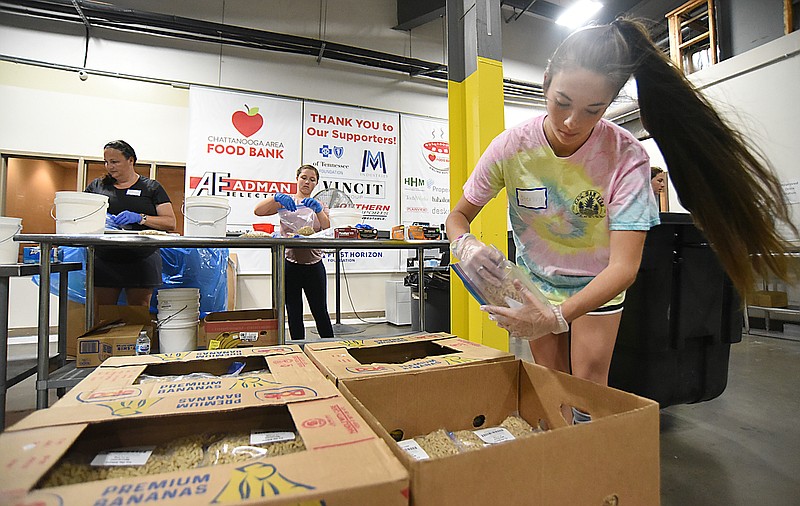When the COVID-19 pandemic shut down schools and many businesses in March 2020, the Chattanooga Area Food Bank saw an immediate spike in the number of area residents needing food assistance after losing their jobs or access to the free- and reduced-price meals traditionally offered in schools.
"For us, COVID created that perfect storm of increased demand, declines in donations of food and a disruption to our charitable food assistance system model," said Jennifer Lockwood Fritts, director of community engagement for the Chattanooga Food Bank.
"But along with a 40% increase in the need for our services in the past year, we also saw an incredible response from the community and the government. One of the great things that this pandemic did was to bring food insecurity into the public eye."
Companies, individuals and foundations boosted their giving on relief efforts, including $750,000 in grants to the Food Bank by the BlueCross BlueShield Foundation.
The government pumped more money into food banks through its Farmers to Families Food Box program, the Tennessee Community Cares Act Program and the Paycheck Protection Program. As a result, the Chattanooga Area Food Bank was able to increase the number of meals offered to needy persons in its 20-county area to a record high of 18 million in the past year.
But most local nonprofit groups didn't fare as well during the economic upheaval caused by the pandemic in the past year.
A recent survey of area charities by the Chattanooga Nonprofit Alliance found 43.3% of local nonprofit agencies reported losses in revenue last year of 30% or less. One in four area nonprofit agencies had a drop in collections of more than 30%. By comparison, just 14% of nonprofits reported gains in revenue in 2020.
"Chattanooga's nonprofits are seeing a K-shaped recovery," said Kim Shumpert, the executive director of the Chattanooga Women's Leadership Institute and chair of the Chattanooga Nonprofit Alliance, referring to a trajectory that doesn't follow a simple V or U shape but follows different paths for different groups.
Charities focused on immediate relief tended to fare better than nonprofits focused on longer-term quality of life improvements in education, arts and culture.
"It's really been tough on many in the arts community," said James McKissic, president of ArtsBuild, the nonprofit agency that advocates for and supports area arts programs. "Everything closed [during the pandemic]; there were layoffs and furloughs, and 83% of local arts and culture organizations reported significant financial losses."
Americans for the Arts, a nonprofit advocacy group, estimates the pandemic cost arts and cultural groups more than $17.5 billion nationwide, including $8.4 million in Hamilton County. During the pandemic, both the Palace Theater in Chattanooga and Ballet Tennessee shut down, McKissic said.
ArtsBuild was able to use government funding to stabilize its budget and work to aid local artists and programs who suffered when virtually all ticket-revenue events were canceled for months last year.
"We were among the first organizations in the nation to establish an artists emergency fund to get cash into the hands of individual artists in Hamilton County," McKissic said. "We created a Grassroots Arts Recovery Fund to send funding each month to the small arts and culture organizations in our city, and we also held weekly Zoom meetings for the arts sector covering a variety of topics, from applying for PPP loans to acquiring personal protective equipment to other national and regional grants that local organizations could apply for."
Shift in giving
Giving to the United Way of Greater Chattanooga - a broad-based fundraising organization that supports 84 local programs - declined by 4.1% in 2020 from the previous year to just more than $6.7 million despite gains in individual and foundation contributions for such programs as the Restore Hope Fund designed to meet immediate COVID-19-related needs in the community.
The drop in giving overall to United Way was because of a $620,317 fall-off in workplace gifts to United Way, primarily because of worker layoffs that temporarily cut employment in metro Chattanooga by nearly 15%, or 38,879 jobs in April 2020.
While most of those jobs have returned to the Chattanooga economy in the past year, many nonprofits are still recovering from their setbacks during the pandemic. As a result, recovery for much of Tennessee's $32 billion-a-year nonprofit sector will likely take some time.
"Coming out of this, it's not going to look like it did before," Shumpert said. "Because of these losses [during the pandemic], we are now in a vast rebuilding, and that rebuilding is going to look different."
The nonprofit alliance survey found 71% of local charities saw a disruption to their services during the pandemic, while 70% saw the cancellation of fundraising events.
"For the nonprofit sector, recovery is much more into 2022 and 2023," Shumpert said. "We're probably going to see a strong two years of rebuilding time."
Government aid
The Paycheck Protection Program or PPP allowed many nonprofits to keep staff in place during the worst of the pandemic, and the state of Tennessee allocated $150 million of its coronavirus relief funds to nonprofits across Tennessee. Gov. Bill Lee said the sector plays "a vital role in ensuring Tennesseans' needs are met in times of crisis."
Nearly 10% of all workers in the state are employed by a nonprofit agency or faith-based organization.
Despite such aid, many people left their jobs at local nonprofits during the pandemic, creating challenges to rebuild the talent pool at many agencies, Shumpert said.
"Even though we had PPP to help us retain some of those employees, it wasn't enough," Shumpert said.
Staff turnover during the pandemic also makes rebuilding more difficult.
"These are experts in dealing with some of the most difficult societal problems of our time," Shumpert said. "The nonprofit sector is the hub for dealing with a lot of the things where other institutions fall short. Where other institutions like business, education, religion or government can't get there, the nonprofit sector serves as the absorption spot for a lot of our problems."
For future funding, donors need to be willing to give flexibility to the recipient agencies to ensure they respond and adapt to changing needs and circumstances, Shumpert said.
"We need multi-year awards to give us the time to test and look at these programs," she said.
Money in the bank
Most nonprofits maintain some financial reserves, but 35.3% said their reserves were diminished during the COVID-19 pandemic and another 20% said they had no reserves.
Nationally, most nonprofits have only a three to six-month funding reserve, according to surveys by the National Council of Nonprofits.
Even before the pandemic hit, the Nonprofit Finance Fund's State of the Sector report revealed less than 25% percent of those nonprofits responding had more than six months of cash in reserve. In fact the majority of the nonprofits responding reported they had less than three months of operating reserves on hand. And close to 10% had less than 30 days of cash on hand.
More than half the respondents to the Chattanooga Nonprofit Alliance latest survey reported that if a shutdown similar to last year were to hit the economy again, they would face an alarmingly high impact or, without relief, would close altogether.
Foundation support
With nearly $1 billion in assets among Chattanooga area foundations, many nonprofits in Chattanooga were fortunate to get extra aid when needed during the pandemic. Historically, Chattanooga also has a higher giving rate among its residents than most communities.
"As is customary in Chattanooga, we saw people really step up and respond generously to meet the immediate and emerging needs from this pandemic," said Maeghan Jones, president of the Community Foundation of Greater Chattanooga. "Giving really mirrored what we usually see with natural disasters where people really come together around a crisis and increase their giving and giving in more flexible ways. We'll see now if that is sustained."
A recent report by the Giving USA Foundation, based on research by the Indiana University Lilly Family School of Philanthropy, estimates foundation giving nationwide last year jumped by 17% to an estimated $88.5 billion while giving from individuals rose 2.2% to $324.1 billion.
"We are grateful for all the local foundations we work with and are fortunate in Chattanooga to have them supporting our community," said Lesley Scearce, CEO of the United Way of Greater Chattanooga. "The Chattanooga nonprofit sector has demonstrated extreme resilience throughout the COVID-19 pandemic, bringing innovative solutions and creative approaches to our community's biggest problems despite the new challenges we all faced.
Nationwide, Giving USA said public-society benefit organizations saw the largest increase in charitable gifts last year, growing 15.7 percent, followed by environmental and animal welfare groups, up 11.6% and human services organizations, up 9.7%. But gifts to health organizations fell 3%, due in part to declines in revenue from fundraising walks, runs and other events. The arts, culture, and humanities sector saw the largest decline in giving, down 7.5%.
Contact Dave Flessner at dflessner@timesfreepress.com or at 423-757-6340.

